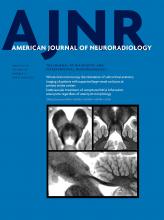Index by author
Soni, N.
- LetterYou have accessEngorged Medullary Veins in Neurosarcoidosis: A Reflection of Underlying Phlebitis?G. Bathla, N. Soni, T. Moritani and A.A. CapizzanoAmerican Journal of Neuroradiology March 2019, 40 (3) E14-E15; DOI: https://doi.org/10.3174/ajnr.A5951
Spelle, L.
- NeurointerventionOpen AccessAneurysm Characteristics, Study Population, and Endovascular Techniques for the Treatment of Intracranial Aneurysms in a Large, Prospective, Multicenter Cohort: Results of the Analysis of Recanalization after Endovascular Treatment of Intracranial Aneurysm StudyM. Gawlitza, S. Soize, C. Barbe, A. le Clainche, P. White, L. Spelle and L. Pierot ARETA Study GroupAmerican Journal of Neuroradiology March 2019, 40 (3) 517-523; DOI: https://doi.org/10.3174/ajnr.A5991
Stajduhar, A.
- Pediatric NeuroimagingOpen AccessUnderdevelopment of the Human Hippocampus in Callosal Agenesis: An In Vivo Fetal MRI StudyV. Knezović, G. Kasprian, A. Štajduhar, E. Schwartz, M. Weber, G.M. Gruber, P.C. Brugger, D. Prayer and M. VukšićAmerican Journal of Neuroradiology March 2019, 40 (3) 576-581; DOI: https://doi.org/10.3174/ajnr.A5986
Sun, J.
- Adult BrainOpen AccessComplementary Roles of Dynamic Contrast-Enhanced MR Imaging and Postcontrast Vessel Wall Imaging in Detecting High-Risk Intracranial AneurysmsH. Qi, X. Liu, P. Liu, W. Yuan, A. Liu, Y. Jiang, Y. Li, J. Sun and H. ChenAmerican Journal of Neuroradiology March 2019, 40 (3) 490-496; DOI: https://doi.org/10.3174/ajnr.A5983
Swanson, K.R.
- FELLOWS' JOURNAL CLUBAdult BrainOpen AccessAccurate Patient-Specific Machine Learning Models of Glioblastoma Invasion Using Transfer LearningL.S. Hu, H. Yoon, J.M. Eschbacher, L.C. Baxter, A.C. Dueck, A. Nespodzany, K.A. Smith, P. Nakaji, Y. Xu, L. Wang, J.P. Karis, A.J. Hawkins-Daarud, K.W. Singleton, P.R. Jackson, B.J. Anderies, B.R. Bendok, R.S. Zimmerman, C. Quarles, A.B. Porter-Umphrey, M.M. Mrugala, A. Sharma, J.M. Hoxworth, M.G. Sattur, N. Sanai, P.E. Koulemberis, C. Krishna, J.R. Mitchell, T. Wu, N.L. Tran, K.R. Swanson and J. LiAmerican Journal of Neuroradiology March 2019, 40 (3) 418-425; DOI: https://doi.org/10.3174/ajnr.A5981
The authors evaluated tumor cell density using a transfer learning method that generates individualized patient models, grounded in the wealth of population data, while also detecting and adjusting for interpatient variabilities based on each patient's own histologic data. They collected 82 image-recorded biopsy samples, from 18 patients with primary GBM. With multivariate modeling, transfer learning improved performance (r = 0.88) compared with one-model-fits-all (r = 0.39). They conclude that transfer learning significantly improves predictive modeling performance for quantifying tumor cell density in glioblastoma.
Takagi, T.
- EDITOR'S CHOICEYou have accessImaging of Patients with Suspected Large-Vessel Occlusion at Primary Stroke Centers: Available Modalities and a Suggested ApproachM.A. Almekhlafi, W.G. Kunz, B.K. Menon, R.A. McTaggart, M.V. Jayaraman, B.W. Baxter, D. Heck, D. Frei, C.P. Derdeyn, T. Takagi, A.H. Aamodt, I.M.R. Fragata, M.D. Hill, A.M. Demchuk and M. GoyalAmerican Journal of Neuroradiology March 2019, 40 (3) 396-400; DOI: https://doi.org/10.3174/ajnr.A5971
Endovascular thrombectomy has proven efficacy for a wide range of patients with large-vessel occlusion stroke and in selected cases up to 24 hours from onset. While primary stroke centers have increased the proportion of patients withstroke receiving thrombolytic therapy, delays can be encountereduntil patients with LVO are identified and transferred from the primary stroke center to acomprehensive stroke center. Therefore, any extra steps need to be carefullyweighed. The use of CTA (especially multiphase) at the primary stroke center levelhas many advantages in expediting the transfer of appropriate patients to a comprehensive center.
Takumi, K.
- Head and Neck ImagingYou have accessEtiology-Specific Mineralization Patterns in Patients with Labyrinthitis OssificansK. Buch, B. Baylosis, A. Fujita, M.M. Qureshi, K. Takumi, P.C. Weber and O. SakaiAmerican Journal of Neuroradiology March 2019, 40 (3) 551-557; DOI: https://doi.org/10.3174/ajnr.A5985
- Head and Neck ImagingYou have accessCT Texture Analysis of Cervical Lymph Nodes on Contrast-Enhanced [18F] FDG-PET/CT Images to Differentiate Nodal Metastases from Reactive Lymphadenopathy in HIV-Positive Patients with Head and Neck Squamous Cell CarcinomaH. Kuno, N. Garg, M.M. Qureshi, M.N. Chapman, B. Li, S.K. Meibom, M.T. Truong, K. Takumi and O. SakaiAmerican Journal of Neuroradiology March 2019, 40 (3) 543-550; DOI: https://doi.org/10.3174/ajnr.A5974
Thomas, Bejoy
- PerspectivesYou have accessPerspectivesBejoy ThomasAmerican Journal of Neuroradiology March 2019, 40 (3) 387; DOI: https://doi.org/10.3174/ajnr.P0055
Tiwari, P.
- FELLOWS' JOURNAL CLUBAdult BrainOpen AccessDisorder in Pixel-Level Edge Directions on T1WI Is Associated with the Degree of Radiation Necrosis in Primary and Metastatic Brain Tumors: Preliminary FindingsP. Prasanna, L. Rogers, T.C. Lam, M. Cohen, A. Siddalingappa, L. Wolansky, M. Pinho, A. Gupta, K.J. Hatanpaa, A. Madabhushi and P. TiwariAmerican Journal of Neuroradiology March 2019, 40 (3) 412-417; DOI: https://doi.org/10.3174/ajnr.A5958
The authors sought to investigate whether co-occurrence of local anisotropic gradient orientations (COLLAGE) measurements from posttreatment gadolinium-contrast T1WI could distinguish varying extents of cerebral radiation necrosis and recurrent tumor classes in a lesion across primary and metastatic brain tumors. On 75 gadolinium-contrast T1WI studies obtained from patients with primary and metastatic brain tumors and nasopharyngeal carcinoma, the extent of cerebral radiation necrosis and recurrent tumor in every brain lesion was histopathologically defined by a neuropathologist as the following: 1) “pure” cerebral radiation necrosis; 2) “mixed” pathology with coexistence of cerebral radiation necrosis and recurrent tumors; 3) “predominant” (>80%) cerebral radiation necrosis; 4) predominant (>80%) recurrent tumor; and 5) pure tumor. COLLAGE features were extracted from the expert-annotated ROIs on MR imaging. COLLAGE features exhibited decreased skewness for patients with pure and predominant cerebral radiation necrosis and were statistically significantly different from those in patients with predominant recurrent tumors, which had highly skewed COLLAGE values.
Tiziano Di Carlo, D.
- NeurointerventionYou have accessFlow-Diversion Treatment of Unruptured Saccular Anterior Communicating Artery Aneurysms: A Systematic Review and Meta-AnalysisF. Cagnazzo, N. Limbucci, S. Nappini, L. Renieri, A. Rosi, A. Laiso, D. Tiziano di Carlo, P. Perrini and S. MangiaficoAmerican Journal of Neuroradiology March 2019, 40 (3) 497-502; DOI: https://doi.org/10.3174/ajnr.A5967








